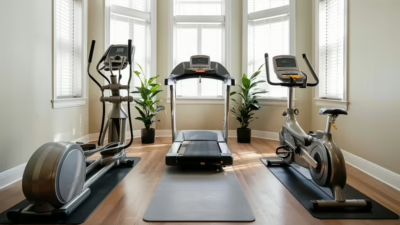Advanced cardio techniques can transform your fitness routine, combining proven methods for maximum results. You’ll want to incorporate HIIT workouts with short, intense bursts of 30 seconds or less, followed by strategic recovery periods. Circuit training adds variety by alternating between upper and lower body exercises, while heart rate zone training helps you target specific fitness goals. Fartlek training mixes up your pace naturally, and bodyweight cardio progressions let you advance without equipment. Whether you’re a beginner or seasoned athlete, these science-backed approaches will help you break through plateaus and discover new levels of cardiovascular fitness.
Maximizing HIIT Performance

How you structure your HIIT intervals can make or break your fitness results. When it comes to advanced cardio techniques, shorter intervals of 30 seconds or less have proven to be game-changers, especially for boosting your endurance and aerobic capacity.
You’ll want to focus on these brief, intense bursts followed by 15-second active recovery periods, which help you maintain performance without feeling completely exhausted.
For those ready to dive into high-intensity cardio techniques, remember that variety is your friend. Mix up your interval lengths and rest periods to keep challenging your body and avoid hitting plateaus.
While cardio training for advanced athletes often emphasizes longer sessions, you’ll find that short intervals can actually lead to better VO2max improvements and more efficient energy use. You’re not just building endurance; you’re also enhancing your explosive strength and cardiovascular health.
To maximize your results with these advanced cardio techniques for fitness, pay close attention to your recovery between sessions.
Listen to your body, adjust intensities based on your fitness level, and gradually increase your training volume to prevent overtraining while steadily improving your performance.
These intense workouts are particularly effective because they trigger elevated metabolic rates that continue burning calories long after you’ve finished exercising.
Advanced Circuit Training Methods
While traditional circuit training delivers reliable results, advanced methods can dramatically amplify your fitness gains. As an experienced lifter looking to enhance your cardio workouts, you’ll find these sophisticated circuit variations particularly effective for pushing past plateaus and maintaining engagement in your training.
You can structure your advanced circuits using methods like the PHA (Peripheral Heart Action) system, where you’ll alternate between upper and lower body exercises with minimal rest to maximize cardiovascular demands.
For an intense challenge, try incorporating Tabata-style intervals, performing 20 seconds of work followed by 10 seconds of rest at each station. The EMOM (Every Minute On the Minute) format adds precision timing to your workout, requiring you to complete specific reps within each 60-second block.
To optimize your results, you’ll want to implement progressive overload by gradually increasing intensity or decreasing rest periods.
Consider using pyramid circuits, where you’ll decrease reps with each round while maintaining or increasing weight, or ladder circuits that adjust your work periods strategically. These advanced techniques ensure you’re continuously challenging your body while maintaining the time-efficient nature of circuit training.
Research shows that incorporating HIIT training methods into your circuits can significantly boost both cardiovascular health and fat loss while improving overall endurance.
Heart Rate Zone Training

Understanding the five heart rate zones is essential for maximizing your cardio training effectiveness. Each zone, calculated as a percentage of your maximum heart rate, serves a specific purpose in your fitness journey.
You’ll find that Zones 1 and 2 (50-70%) are perfect for building endurance and burning fat, while Zones 3 and 4 (70-90%) help improve your cardiovascular fitness and speed.
To determine your zones, you can use several methods, including the basic formula of 220 minus your age, or the more precise Karvonen method that factors in your resting heart rate.
If you’re an athlete seeking exact measurements, you might prefer the Zoladz method, which uses your lactate threshold heart rate.
When you’re training, you’ll want to mix up your zones based on your goals. If you’re focusing on weight loss, you’ll benefit from spending more time in the lower zones, where your body primarily burns fat.
For performance improvements, you’ll need to incorporate higher zones, but remember to consult your healthcare provider before attempting high-intensity work in Zones 4 and 5, as these can be challenging for your body.
Regular cardio exercise benefits include improved heart health and enhanced overall fitness levels.
Fartlek Training Fundamentals
Distance runners swear by fartlek training, a Swedish approach that literally means “speed play” in English. You’ll love how this versatile workout method combines continuous running with varying speeds and intensities, making each session unique and challenging.
During a fartlek workout, you’ll start with a proper warm-up, then alternate between high-intensity bursts and recovery periods, finally ending with a cool-down phase.
What makes fartlek training so effective is its flexibility and natural approach to cardio. You can structure your workout around landmarks, hills, or even your favorite music, choosing when to push harder and when to recover. This adaptability helps you build both speed and endurance while keeping your workouts fresh and engaging.
- Time-based intervals: Alternate between one minute of fast running and two minutes of easy jogging
- Landmark-based training: Sprint to specific objects like trees or street signs, then recover until the next target
- Music-driven workouts: Push hard during choruses and recover during verses
Remember to start gradually and listen to your body, adjusting the intensity as needed. You’ll find that fartlek training not only improves your physical fitness but also builds mental toughness for race day. Regular fartlek sessions can help reduce stress and anxiety through the natural release of endorphins.
Bodyweight Cardio Progressions

Moving beyond fartlek training’s variable speeds, bodyweight cardio progressions offer a systematic way to challenge your cardiovascular system without equipment.
You’ll find three main ways to increase difficulty: volume adjustments, tempo modifications, and base of support variations, all of which work together to create comprehensive workouts.
When you’re ready to progress, start by increasing your volume through ladder techniques, where you’ll gradually add more reps and sets to your routine.
You can then fine-tune the intensity by adjusting your tempo, such as using a 3-1-3-1 count for push-ups, which creates more time under tension and develops better control over your movements.
For an extra challenge, you’ll want to experiment with your base of support.
Try narrowing your stance during squats or transitioning from two-legged to single-leg exercises. These modifications force your body to work harder against different forces while maintaining stability.
As you combine these progression methods, you’ll create a well-rounded approach that prevents plateaus and keeps your cardio training fresh and effective.
Understanding the distinction between flexibility and mobility will help you perform these bodyweight exercises with better form and reduced risk of injury.
You’ve now got a powerful toolkit of advanced cardio techniques to take your fitness to new heights. From the intensity of HIIT to the strategic pacing of heart rate zones, you’re equipped to make every workout count. Whether you’re mixing up your routine with Fartlek training or mastering bodyweight progressions, these methods will help you build endurance, strength, and cardiovascular health. Put these techniques into practice, and you’ll see remarkable improvements in your fitness journey.



